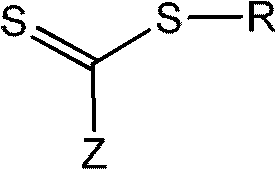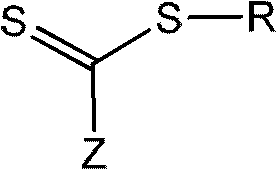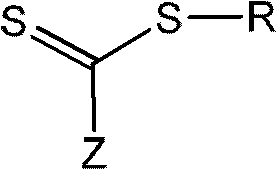Preparation method of segmented copolymer from vinylidene chloride copolymer and polyethylene glycol
A technology of block copolymer and vinylidene chloride, applied in the field of preparation of block copolymer, can solve the problems of no block copolymer, increasing the molecular composition and difficulty of structure control of vinylidene chloride polymer, etc.
- Summary
- Abstract
- Description
- Claims
- Application Information
AI Technical Summary
Problems solved by technology
Method used
Image
Examples
preparation example Construction
[0017] The steps of the preparation method of the block copolymer that are made up of vinylidene chloride polymer and polyethylene glycol are as follows:
[0018] (1) Dissolve 1.0mol polyethylene glycol and 2.0-2.5mol reversible addition-fragmentation chain transfer polymerization chain transfer reagent in 130-170mol methylene chloride, mix well, add 2-2.5mol water remover dicyclohexyl carbon Diimine and 0.4-0.5mol catalyst 4-dimethylaminopyridine, esterification reaction at 25°C for 24-72 hours, after repeated precipitation, dissolution, and drying to obtain a macromolecular reversible addition-fragmentation chain transfer polymerization chain transfer reagent ;
[0019] (2) Add 50-100 parts by mass of 1,4-dioxane, 5-20 parts by mass of vinylidene chloride, and 2-7 parts by mass of macromolecular reversible addition-fragmentation chain transfer polymer chain Transfer reagent, 0.016-0.16 parts by mass of azobisisobutyronitrile initiator, or add 50-100 parts by mass of 1,4-dio...
Embodiment 1
[0026](1) 0.007 mol of polyethylene glycol with a molecular weight of 2000 and 0.0156 mol of reversible addition-fragmentation chain transfer polymerization chain transfer reagent S-1-dodecyl-S'-(α, α'-dimethyl- α”-acetic acid) trithiocarbonate dissolved in 1.1mol methylene chloride, mixed evenly, adding 0.0155mol water remover dicyclohexylcarbodiimide and 0.003mol catalyst 4-dimethylaminopyridine, at 25°C After 24 hours of esterification reaction, after repeated precipitation, dissolution, and drying, a macromolecular reversible addition-fragmentation chain transfer polymer chain transfer reagent was obtained;
[0027] (2) Add 100 grams of 1,4-dioxane, 10.8 grams of vinylidene chloride and 1.2 grams of methyl acrylate, 2 grams of macromolecular reversible addition-fragmentation chain transfer polymerization chain transfer reagent, 0.015 grams of azobisisobutyronitrile initiator, stirred at room temperature for 10 minutes to dissolve and mix the reactants, nitrogen and deoxyge...
Embodiment 2
[0029] (1) 0.007 mol of polyethylene glycol with a molecular weight of 10000 and 0.0156 mol of reversible addition-fragmentation chain transfer polymerization chain transfer reagent S-1-dodecyl-S'-(α, α'-dimethyl- α”-acetic acid) trithiocarbonate was dissolved in 0.91mol of dichloromethane, mixed evenly, adding 0.0155mol of dehydrating agent dicyclohexylcarbodiimide and 0.003mol of catalyst 4-dimethylaminopyridine, at 25°C Esterification reaction for 48 hours, after repeated precipitation, dissolution, and drying to obtain a macromolecular reversible addition-fragmentation chain transfer polymer chain transfer reagent;
[0030] (2) Add 80 grams of 1,4-dioxane, 10.8 grams of vinylidene chloride and 1.2 grams of methyl acrylate, 6.4 grams of macromolecular reversible addition-fragmentation chain transfer polymerization chain transfer reagent, 0.015 grams of azobisisobutyronitrile initiator, stirred at room temperature for 30 minutes to dissolve and mix the reactant, nitrogen deo...
PUM
| Property | Measurement | Unit |
|---|---|---|
| Number average molecular weight | aaaaa | aaaaa |
Abstract
Description
Claims
Application Information
 Login to View More
Login to View More - R&D
- Intellectual Property
- Life Sciences
- Materials
- Tech Scout
- Unparalleled Data Quality
- Higher Quality Content
- 60% Fewer Hallucinations
Browse by: Latest US Patents, China's latest patents, Technical Efficacy Thesaurus, Application Domain, Technology Topic, Popular Technical Reports.
© 2025 PatSnap. All rights reserved.Legal|Privacy policy|Modern Slavery Act Transparency Statement|Sitemap|About US| Contact US: help@patsnap.com



